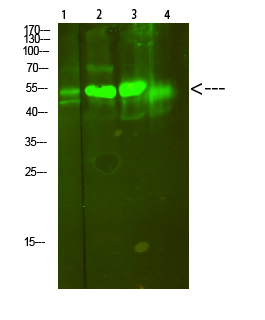V-ATPase S1 Polyclonal Antibody
- Catalog No.:YT6079
- Applications:WB;ELISA
- Reactivity:Human;Mouse;Rat
- Target:
- V-ATPase S1
- Fields:
- >>Oxidative phosphorylation;>>Metabolic pathways;>>Lysosome;>>Phagosome;>>Vibrio cholerae infection;>>Epithelial cell signaling in Helicobacter pylori infection;>>Tuberculosis;>>Hepatitis B;>>Human papillomavirus infection;>>Rheumatoid arthritis
- Gene Name:
- ATP6AP1
- Protein Name:
- V-ATPase S1
- Human Gene Id:
- 537
- Human Swiss Prot No:
- Q15904
- Mouse Gene Id:
- 54411
- Mouse Swiss Prot No:
- Q9R1Q9
- Immunogen:
- Synthesized peptide derived from human V-ATPase S1. at AA range: 421-470
- Specificity:
- V-ATPase S1 Polyclonal Antibody detects endogenous levels of V-ATPase S1
- Formulation:
- Liquid in PBS containing 50% glycerol, 0.5% BSA and 0.02% sodium azide.
- Source:
- Polyclonal, Rabbit,IgG
- Dilution:
- WB 1:500-2000, ELISA 1:10000-20000
- Purification:
- The antibody was affinity-purified from rabbit antiserum by affinity-chromatography using epitope-specific immunogen.
- Concentration:
- 1 mg/ml
- Storage Stability:
- -15°C to -25°C/1 year(Do not lower than -25°C)
- Other Name:
- V-type proton ATPase subunit S1 (V-ATPase subunit S1) (Protein XAP-3) (V-ATPase Ac45 subunit) (V-ATPase S1 accessory protein) (Vacuolar proton pump subunit S1)
- Observed Band(KD):
- 51kD
- Background:
- This gene encodes a component of a multisubunit enzyme that mediates acidification of eukaryotic intracellular organelles. Vacuolar ATPase (V-ATPase) is comprised of a cytosolic V1 (site of the ATP catalytic site) and a transmembrane V0 domain. V-ATPase dependent organelle acidification is necessary for such intracellular processes as protein sorting, zymogen activation, and receptor-mediated endocytosis. The encoded protein of this gene may assist in the V-ATPase-mediated acidification of neuroendocrine secretory granules. This protein may also play a role in early development. [provided by RefSeq, Aug 2013],
- Function:
- function:Vacuolar ATPase is responsible for acidifying a variety of intracellular compartments in eukaryotic cells.,similarity:Belongs to the vacuolar ATPase subunit S1 family.,subunit:Composed of at least 10 subunits.,tissue specificity:Ubiquitous.,
- Subcellular Location:
- Endoplasmic reticulum membrane ; Single-pass type I membrane protein . Endoplasmic reticulum-Golgi intermediate compartment membrane . Cytoplasmic vesicle, secretory vesicle, synaptic vesicle membrane ; Single-pass type I membrane protein . Cytoplasmic vesicle, clathrin-coated vesicle membrane ; Single-pass type I membrane protein . Not detected in trans-Golgi network. .
- Expression:
- widely expressed, with highest levels in brain and lowest in liver and duodenum.
- June 19-2018
- WESTERN IMMUNOBLOTTING PROTOCOL
- June 19-2018
- IMMUNOHISTOCHEMISTRY-PARAFFIN PROTOCOL
- June 19-2018
- IMMUNOFLUORESCENCE PROTOCOL
- September 08-2020
- FLOW-CYTOMEYRT-PROTOCOL
- May 20-2022
- Cell-Based ELISA│解您多样本WB检测之困扰
- July 13-2018
- CELL-BASED-ELISA-PROTOCOL-FOR-ACETYL-PROTEIN
- July 13-2018
- CELL-BASED-ELISA-PROTOCOL-FOR-PHOSPHO-PROTEIN
- July 13-2018
- Antibody-FAQs
- Products Images

- Western Blot analysis of 1,mouse-lung 2,mouse-brain 3,mouse-spleen 4,mouse-kidney cells using primary antibody diluted at 1:500(4°C overnight). Secondary antibody:Goat Anti-rabbit IgG IRDye 800( diluted at 1:5000, 25°C, 1 hour)



